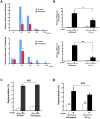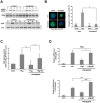A novel role of the L-type calcium channel α1D subunit as a gatekeeper for intracellular zinc signaling: zinc wave - PubMed (original) (raw)
A novel role of the L-type calcium channel α1D subunit as a gatekeeper for intracellular zinc signaling: zinc wave
Satoru Yamasaki et al. PLoS One. 2012.
Abstract
Recent studies have shown that zinc ion (Zn) can behave as an intracellular signaling molecule. We previously demonstrated that mast cells stimulated through the high-affinity IgE receptor (FcεRI) rapidly release intracellular Zn from the endoplasmic reticulum (ER), and we named this phenomenon the "Zn wave". However, the molecules responsible for releasing Zn and the roles of the Zn wave were elusive. Here we identified the pore-forming α(1) subunit of the Cav1.3 (α(1D)) L-type calcium channel (LTCC) as the gatekeeper for the Zn wave. LTCC antagonists inhibited the Zn wave, and an agonist was sufficient to induce it. Notably, α(1D) was mainly localized to the ER rather than the plasma membrane in mast cells, and the Zn wave was impaired by α(1D) knockdown. We further found that the LTCC-mediated Zn wave positively controlled cytokine gene induction by enhancing the DNA-binding activity of NF-κB. Consistent with this finding, LTCC antagonists inhibited the cytokine-mediated delayed-type allergic reaction in mice without affecting the immediate-type allergic reaction. These findings indicated that the LTCC α(1D) subunit located on the ER membrane has a novel function as a gatekeeper for the Zn wave, which is involved in regulating NF-κB signaling and the delayed-type allergic reaction.
Conflict of interest statement
Competing Interests: The authors have declared that no competing interests exist.
Figures
Figure 1. The α1D subunit of LTCC is primarily expressed on the ER membrane in mast cells.
(A) RT-PCR of mRNA encoding the α1 subunit of LTCC family members (cacna1s, cacna1c, cacna1d, and cacna1f), and Gapdh in BMMCs. (B) Western blot for α1D in BMMCs. Total cell lysates were blotted with an anti-α1D polyclonal antibody or the same antibody pre-incubated with an antigenic peptide. Arrowhead indicates the putative α1D signal; this signal detected by the antibody pre-incubated with antigenic peptide was 15.1±11.1% of that detected by the anti-α1D polyclonal antibody. (C) Intracellular distribution of the LTCC α1D subunit in BMMCs examined by confocal microscopy. Representative images are shown. Staining with an anti-α1D monoclonal antibody is in green, anti-Calnexin (ER marker) in red, or phalloidin-Alexa 546 (for F-actin beneath the plasma membrane) in red, and 4′ 6-diamidino-2-phenylindole, dihydrochloride (DAPI; for nuclei) in blue. (D) The postnuclear supernatant obtained from BMMCs was fractionated by ultracentrifugation in a discontinuous sucrose gradient. The collected fractions were then separated by SDS-PAGE, and the protein distributions were detected by immunoblotting with antibodies against α1D, SERCA2 (ER), and LAT (plasma membrane). (E) The mRNA expression of LTCC β-subunit family members (_cacnb_1 to _cacnb_4) in the brain and BMMCs was examined by RT-PCR. (F) The protein levels of the β2 and β4 subunits in the brain and BMMCs were examined by western blots.
Figure 2. LTCC is involved in regulation of the Zn wave.
(A) The intracellular labile Zn level after FcεRI-mediated stimulation was examined using the fluorescent Zn indicator Newport Green in mast cells with or without pre-treatment with 100 µM Verapamil, an LTCC antagonist. The data represent the relative fluorescent intensity of Newport Green. The difference in Newport Green intensity at 15 min between the control and Verapamil-treated BMMCs was statistically significant. *P<0.05, Student’s _t_-test. (B) The FcεRI-mediated Ca2+ elevation in control and Verapamil-treated BMMCs was examined using the fluorescent Ca2+ indicator Fluo-4. Data represent the relative fluorescent intensity of Fluo-4. The difference in Fluo-4 intensity between the control and Verapamil-treated BMMCs was not statistically significant. (C) The intracellular labile Zn level upon treatment with the LTCC agonist (s)-(-)-BayK8644 in BMMCs with or without 100 µM Verapamil. The difference in Newport Green intensity at 15 min between the control and Verapamil-treated BMMCs was statistically significant. ***P<0.001. (D) The intracellular labile Zn level upon (s)-(-)-BayK8644 treatment of BMMCs in control or Ca2+-free Tyrode’s buffer. The difference in Fluo-4 intensity between the control and Ca2+-free Tyrode’s buffer samples was not statistically significant. All data are representative of at least three experiments, and are shown as the mean + SEM. NPG, Newport Green; Vera, Verapamil; Bay, (s)-(-)-BayK8644.
Figure 3. Effect of α1D knockdown on the FcεRI-mediated Zn wave.
(A) The intracellular labile Zn level upon antigen stimulation was examined in control and α1D siRNA-treated BMMCs. The difference in Newport Green intensity at 15 min between the control and α1D siRNA-treated BMMCs was statistically significant. *P<0.05, Student’s _t_-test. (B) The intracellular Ca2+ level upon antigen stimulation was examined in control and α1D siRNA-treated BMMCs. The difference in Fluo-4 intensity between the control and α1D siRNA-treated BMMCs was not statistically significant. (C) The FcεRI-mediated Zn wave was examined in α1D siRNA-treated BMMCs with or without transfection of human α1D. All data represent the mean + SEM. N.S., not significant, *P<0.05, ***P<0.001, Bonferroni’s multiple comparison test. NPG, Newport Green.
Figure 4. The LTCC-mediated Zn wave is involved in cytokine gene inductions.
(A) The FcεRI-mediated inductions of Il6 and Tnfa transcription upon antigen stimulation for the indicated time in BMMCs with or without pretreatment with 100 µM Verapamil were determined by semi-quantitative RT-PCR. (B) The mRNA levels of Il6 and Tnfa upon antigen stimulation for 60 min in control (siControl) or α1D siRNA-treated (si α1D) BMMCs were determined by semi-quantitative RT-PCR. (C) The level of degranulation after 30 min of antigen stimulation in BMMCs with or without pretreatment with 100 µM Verapamil was determined by measuring the β-hexosaminidase activity. (D) Level of degranulation after 30 min of antigen stimulation in siControl and α1D siRNA-treated BMMCs. N.S., not significant, *P<0.05, **P<0.01, two-tailed Student’s _t_-test.
Figure 5. Possible involvement of the Zn wave in regulating the DNA-binding activity of p65 NF-κB.
(A) IKKα/β phosphorylation and IκBα phosphorylation and degradation. After antigen stimulation, cells were lysed, and the cytosol fraction was immunoblotted with anti-phospho-IκBα or anti-phospho-IKKα/β antibodies. Results were normalized to the non-phosphorylated IκBα and IKKα. (B) NF-κB nuclear translocation visualized by confocal microscopy. BMMCs were untreated or treated with Verapamil and stimulated with antigen for 15 min. Cells were stained with anti-p65 (green) and DAPI (blue). Scale bar, 10 µm. The frequency of NF-κB nuclear-translocated cells was calculated. Values are means + S.D. *P<0.05, two-tailed Student’s _t_-test. (C) DNA-binding activity was calculated by dividing the amount of p65 bound to target DNA by the total p65 in the nuclear fraction. BMMCs were untreated or pre-treated with Verapamil, then stimulated with antigen for 15 min. For Zn supplementation, 1 µM Zn and pyrithione were added with the antigen stimulation. (D) BMMCs were untreated or treated with Verapamil, and stimulated with antigen for 60 min. Zn supplementation was as in (C). The Il6 and Tnfa mRNA levels were determined by semi-quantitative RT-PCR. Data show means + S.D. N.S., not significant, *P<0.05, **P<0.01, ***P<0.001, Bonferroni’s multiple comparison test.
Figure 6. Effect of Verapamil treatment on allergic responses in vivo.
(A) Analysis of passive cutaneous anaphylaxis, an immediate-type allergy response. Vehicle- or Verapamil-treated mice received intradermal injections of IgE anti-DNP into the right ear and saline into the left (control). Data show the amount of Evans blue extravasation into the ears. (n = 8 per group, from two independent experiments). N.S., not significant. (B) Analysis of contact hypersensitivity, a delayed-type allergic response. Vehicle- or Verapamil-treated mice were sensitized with FITC, and ear swelling was measured at the indicated times after hapten challenge. Data show means + SEM. (n = 5 per group, experiment performed three times). **P<0.01, ***P<0.001, two-tailed Student’s _t_-test.
Similar articles
- [Regulatory Mechanism of Mast Cell Activation by Zinc Signaling].
Nishida K, Uchida R. Nishida K, et al. Yakugaku Zasshi. 2017;137(5):495-501. doi: 10.1248/yakushi.16-00239-1. Yakugaku Zasshi. 2017. PMID: 28458279 Review. Japanese. - L-Type Calcium Channel-Mediated Zinc Wave Is Involved in the Regulation of IL-6 by Stimulating Non-IgE with LPS and IL-33 in Mast Cells and Dendritic Cells.
Uchida R, Xiang H, Arai H, Kitamura H, Nishida K. Uchida R, et al. Biol Pharm Bull. 2019 Jan 1;42(1):87-93. doi: 10.1248/bpb.b18-00565. Epub 2018 Nov 10. Biol Pharm Bull. 2019. PMID: 30416166 - L-type Ca2+ channels in mast cells: activation by membrane depolarization and distinct roles in regulating mediator release from store-operated Ca2+ channels.
Yoshimaru T, Suzuki Y, Inoue T, Ra C. Yoshimaru T, et al. Mol Immunol. 2009 Apr;46(7):1267-77. doi: 10.1016/j.molimm.2008.11.011. Epub 2009 Jan 6. Mol Immunol. 2009. PMID: 19128833 - Zinc transporter Znt5/Slc30a5 is required for the mast cell-mediated delayed-type allergic reaction but not the immediate-type reaction.
Nishida K, Hasegawa A, Nakae S, Oboki K, Saito H, Yamasaki S, Hirano T. Nishida K, et al. J Exp Med. 2009 Jun 8;206(6):1351-64. doi: 10.1084/jem.20082533. Epub 2009 May 18. J Exp Med. 2009. PMID: 19451265 Free PMC article. - [Role of zinc transporter in allergic reactions].
Nishida K. Nishida K. Yakugaku Zasshi. 2011 Jan;131(1):85-92. doi: 10.1248/yakushi.131.85. Yakugaku Zasshi. 2011. PMID: 21212618 Review. Japanese.
Cited by
- The Zinc Sensing Receptor, ZnR/GPR39, in Health and Disease.
Hershfinkel M. Hershfinkel M. Int J Mol Sci. 2018 Feb 1;19(2):439. doi: 10.3390/ijms19020439. Int J Mol Sci. 2018. PMID: 29389900 Free PMC article. Review. - Serum Free Zinc Is Associated With Vaccination Response to SARS-CoV-2.
Chillon TS, Maares M, Demircan K, Hackler J, Sun Q, Heller RA, Diegmann J, Bachmann M, Moghaddam A, Haase H, Schomburg L. Chillon TS, et al. Front Immunol. 2022 Jun 30;13:906551. doi: 10.3389/fimmu.2022.906551. eCollection 2022. Front Immunol. 2022. PMID: 35844578 Free PMC article. - Understanding the Contribution of Zinc Transporters in the Function of the Early Secretory Pathway.
Kambe T, Matsunaga M, Takeda TA. Kambe T, et al. Int J Mol Sci. 2017 Oct 19;18(10):2179. doi: 10.3390/ijms18102179. Int J Mol Sci. 2017. PMID: 29048339 Free PMC article. Review. - Mast cells play role in wound healing through the ZnT2/GPR39/IL-6 axis.
Nishida K, Hasegawa A, Yamasaki S, Uchida R, Ohashi W, Kurashima Y, Kunisawa J, Kimura S, Iwanaga T, Watarai H, Hase K, Ogura H, Nakayama M, Kashiwakura JI, Okayama Y, Kubo M, Ohara O, Kiyono H, Koseki H, Murakami M, Hirano T. Nishida K, et al. Sci Rep. 2019 Jul 25;9(1):10842. doi: 10.1038/s41598-019-47132-5. Sci Rep. 2019. PMID: 31346193 Free PMC article. - The zinc transporter, Slc39a7 (Zip7) is implicated in glycaemic control in skeletal muscle cells.
Myers SA, Nield A, Chew GS, Myers MA. Myers SA, et al. PLoS One. 2013 Nov 12;8(11):e79316. doi: 10.1371/journal.pone.0079316. eCollection 2013. PLoS One. 2013. PMID: 24265765 Free PMC article.
References
- Andreini C, Banci L, Bertini I, Rosato A. Counting the zinc-proteins encoded in the human genome. J Proteome Res. 2006;5:196–201. - PubMed
- Hambidge M. Human zinc deficiency. J Nutr. 2000;130:1344S–1349S. - PubMed
- Prasad AS. Recognition of zinc-deficiency syndrome. Nutrition. 2001;17:67–69. - PubMed
- Maret W. Metals on the move: zinc ions in cellular regulation and in the coordination dynamics of zinc proteins. Biometals. 2011;24:411–418. - PubMed
- Hirano T, Murakami M, Fukada T, Nishida K, Yamasaki S, et al. Roles of zinc and zinc signaling in immunity: zinc as an intracellular signaling molecule. Adv Immunol. 2008;97:149–176. - PubMed
Publication types
MeSH terms
Substances
LinkOut - more resources
Full Text Sources
Miscellaneous





